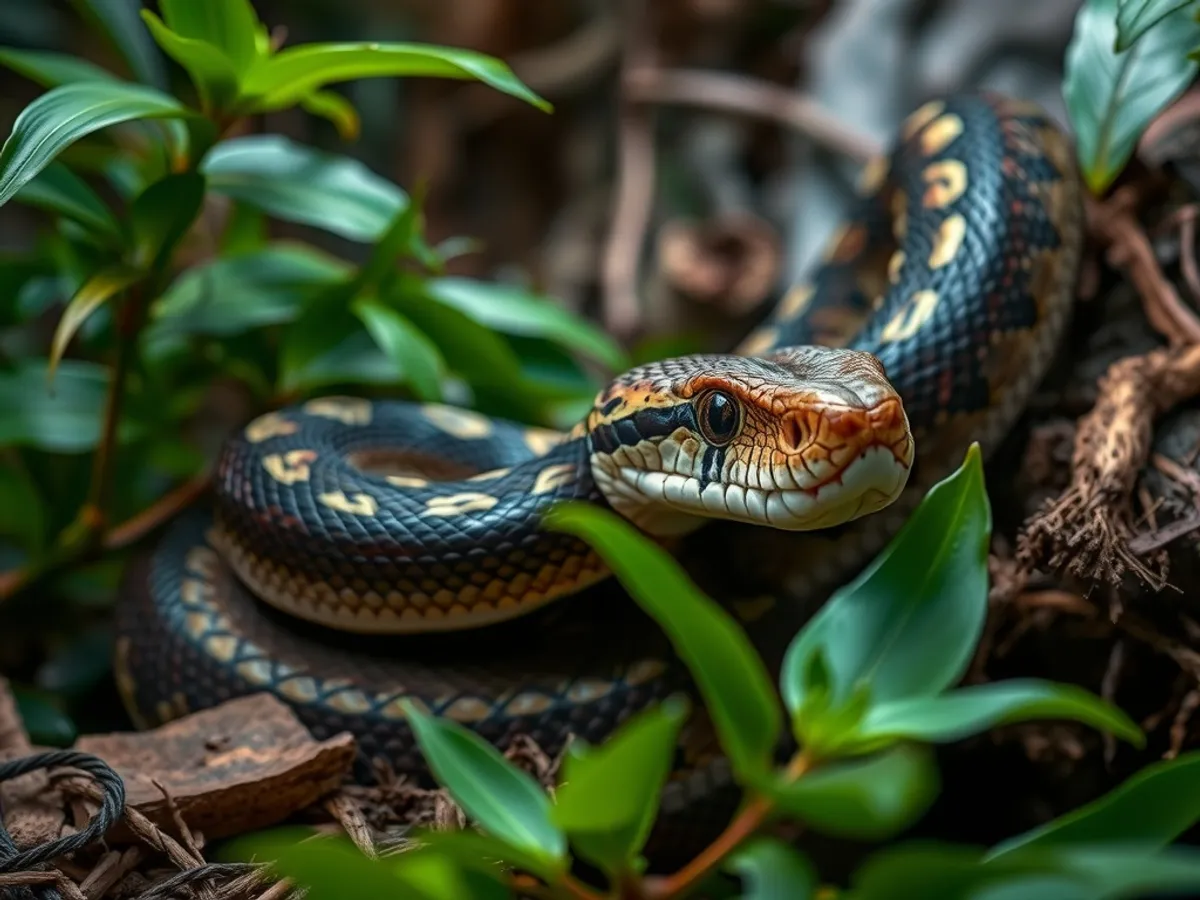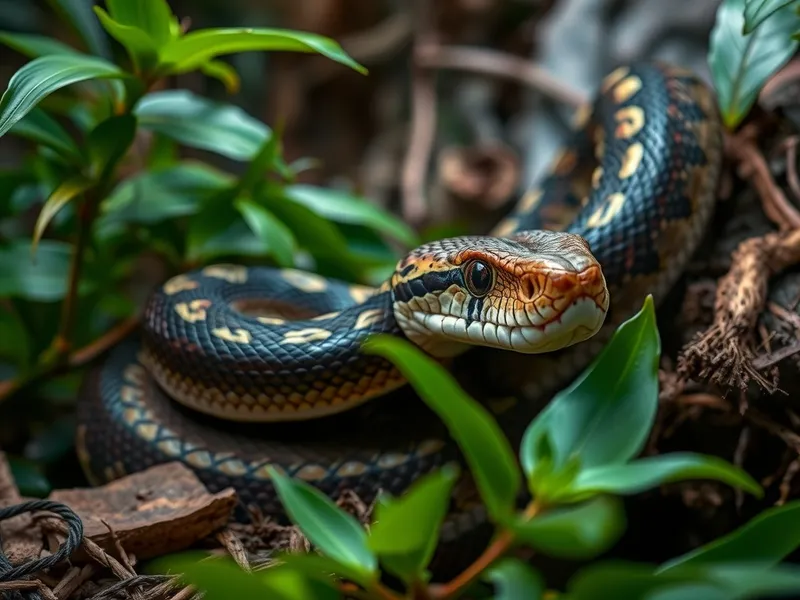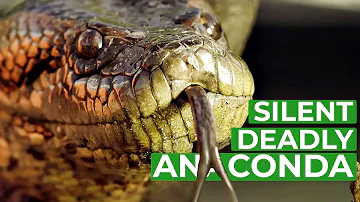
Boa Constrictor
Boa constrictor

Meet the Boa Constrictor
The Boa Constrictor is a large, non-venomous snake native to Central and South America. Recognized for its powerful, muscular body and distinctive brown and cream saddle-like markings, this snake can grow to impressive lengths. It is an ambush predator, using stealth and its strong coils to subdue prey. Boa Constrictors thrive in a variety of habitats, from tropical rainforests to arid savannas, and are primarily solitary animals. Their adaptability and striking appearance have made them popular in the exotic pet trade.
Classification
Reptile
Habitat
Tropical rainforest
Diet
Carnivore
Lifespan
20-30 years
Conservation
Least Concern
Weight
10-15 kg (22-33 lbs)
📖Fascinating Facts
Powerful Constrictor
Boa Constrictors kill their prey by wrapping around them and squeezing until the animal suffocates.
Live Birth
Unlike many other snakes, Boa Constrictors do not lay eggs but give birth to live young, with litters sometimes exceeding 60 offspring.
Habitat Versatility
They are found in a variety of environments, including forests, savannas, and agricultural areas, showing remarkable adaptability.
📋Detailed Description
The Boa constrictor is a robust, heavy-bodied snake, typically ranging from 2 to 4 meters (6.5–13 feet) in length, with some individuals exceeding 4 meters, though most average between 2 and 3 meters. Its coloration is highly variable, often reflecting its local habitat, but generally features a background of brown, gray, or cream with darker saddle-shaped markings that become more pronounced toward the tail. The head is distinct from the neck, with prominent stripes running from the snout through the eyes. Boa constrictors possess heat-sensitive labial pits, allowing them to detect warm-blooded prey even in low-light conditions. Their muscular bodies are adapted for both climbing and terrestrial movement, and they are capable swimmers. Primarily nocturnal, boas spend daylight hours concealed in burrows, hollow logs, or dense foliage. They are solitary except during the breeding season and are known for their ambush predation strategy, relying on stealth and rapid strikes. Their jaws are highly flexible, enabling them to consume prey much larger than their head diameter. Boa constrictors are ovoviviparous, giving birth to live young rather than laying eggs, a trait that distinguishes them from many other snakes.
💡 Did you know?
A Boa Constrictor can swallow prey much larger than its head by unhinging its jaws.
🔬Research & Sources
Wikipedia Summary
The boa constrictor, also known as the common boa, is a species of large, non-venomous, heavy-bodied snake that is frequently kept and bred in captivity. The boa constrictor is a member of the family Boidae. The species is native to tropical South America. A staple of private collections and public displays, its color pattern is highly variable yet distinctive. Four subspecies are recognized.
Last Modified: 6/4/2025
🎭Behavior & Social Structure
Boa constrictors are predominantly solitary and territorial, with individuals maintaining home ranges that can overlap but are generally respected. They are ambush predators, remaining motionless for extended periods and striking rapidly when prey approaches. Their diet consists mainly of small to medium-sized mammals, birds, and occasionally reptiles, with juveniles targeting smaller prey such as rodents and lizards. Boas kill by constriction, wrapping their coils around the prey and tightening with each exhalation until suffocation occurs. Feeding frequency varies with age and prey size; adults may eat once every few weeks. Boas are primarily nocturnal, becoming active at dusk and throughout the night. They are adept climbers, especially when young, and may spend significant time in trees, but adults are more terrestrial. Defensive behaviors include hissing, striking, and body inflation to appear larger. They rarely bite unless provoked.
👶Reproduction & Life Cycle
Boa constrictors are ovoviviparous, with internal fertilization and live birth. Mating typically occurs during the dry season (April to August in much of their range), triggered by environmental cues such as temperature and photoperiod. Males locate receptive females by following pheromone trails and may engage in combat with rivals. Courtship involves tactile stimulation, with males using their vestigial pelvic spurs to stroke the female. Gestation lasts approximately 100–120 days, after which the female gives birth to 10–65 live young, each measuring 40–60 cm (16–24 inches) at birth. Neonates are independent from birth and receive no parental care. Sexual maturity is reached at 3–4 years, with females generally maturing later and at larger sizes than males.
🛡️Adaptations & Survival
Boa constrictors exhibit several adaptations for survival. Their cryptic coloration provides effective camouflage in diverse habitats, from rainforest leaf litter to arid scrub. Heat-sensitive pits along the lips allow detection of endothermic prey in darkness. Their muscular bodies and prehensile tails aid in climbing and anchoring among branches, especially in juveniles. The flexible jaw structure, with loosely connected bones and elastic ligaments, enables ingestion of large prey. Slow metabolism allows them to survive long periods between meals. Ovoviviparity is an adaptation to fluctuating environmental conditions, protecting developing young from predation and temperature extremes. Defensive behaviors, such as hissing and body inflation, deter predators.
📚Research Sources
🎨Cultural Significance
Boa constrictors have long held significance in indigenous cultures of Central and South America, often featured in mythology and folklore as symbols of power, fertility, or transformation. They have been used in traditional medicine and rituals, and their skins are valued for leather goods. In modern times, boas are popular in the exotic pet trade and are frequently displayed in zoos and educational programs, contributing to public awareness of reptile biology and conservation. However, their popularity as pets has also led to issues with invasive populations and abandonment.
🔬Recent Research & Discoveries
Recent research on Boa constrictors has focused on their ecological roles as apex mesopredators, their physiological adaptations to fasting and digestion, and their genetic diversity across their range. Studies using molecular markers have clarified subspecies boundaries and evolutionary history, revealing significant genetic structuring among populations. Ongoing research investigates the impacts of habitat fragmentation and climate change on their distribution. Invasive populations, particularly in Florida, are subjects of ecological and management studies. Advances in reproductive biology, including sperm storage and parthenogenesis, have been documented in captivity. Conservation genetics and disease surveillance are emerging areas of study, particularly regarding the pet trade and potential pathogen transmission.
🎥Wildlife Videos

Cold-Blooded Wonders - The Secret Lives of Snakes and Lizards | Full Documentary
Wrapped up in myths and misunderstandings, “cold-blooded” Reptiles are a diverse group with thousands of species crawling, ...
Free High-Quality Documentaries

World's Most Venomous Snakes: Ultimate Faceoff (Full Episode) | When Predators Attack
Watch what unfolds when the world's most venomous snakes and largest constrictors face off against prey and people. S1, E1 ...
Nat Geo Animals

What Are a Boa Constrictor's Favorite Prey? 🐍 | Smithsonian
With the prison of Gorgona long gone, rats have taken over the ruins. Helping keep their numbers in check is a slithery killer with ...
Smithsonian Channel

THE BOA CONSTRICTOR MOVIE (An Original Film)
The Boa Constrictor Movie takes an in depth look into the two most popular boa species in reptile keeping as it takes you on an ...
Dāv Kaufman's Reptile Adventures

Boa imperator, big constrictor snake, Tree boas, Corallus, Dumeril's boa, Acrantophis, booid snakes
Boas are very famous snakes. Boa constrictor and Boa imperator (Common boa) are very common in captivity as pets.
Living Zoology

Anaconda - The Silent Killer | Free Documentary Nature
Anaconda - The Silent Killer | Wildlife Documentary Watch 'Sea of Snakes - In the Realm of the Deadly Niue Sea Krait' here: ...
Free Documentary - Nature
🌍Habitat Information
The Boa Constrictor typically inhabits Tropical rainforest environments. Boa Constrictors have adapted to their environments with specialized features and behaviors.
Primary Habitat:
Tropical rainforest
More detailed habitat information will be available soon.
🛡️Conservation Status
The Boa Constrictor is currently classified as Least Concern. Conservation efforts are crucial for preserving this species for future generations.
Common Threats:
- 🏠Habitat loss and fragmentation
- 🌡️Climate change impacts
- 🎯Hunting and poaching
- 🏭Human-wildlife conflict
⚠️Threats & Conservation Challenges
While classified as Least Concern by the IUCN, Boa constrictors face localized threats. Habitat destruction due to deforestation, agricultural expansion, and urbanization reduces available territory and prey. They are hunted for their skins, meat, and for the pet trade, with some populations experiencing declines from over-collection. Road mortality and persecution due to fear or misunderstanding also impact numbers. Introduced populations, such as in Florida, raise ecological concerns. Despite these pressures, their wide distribution and adaptability have helped maintain stable overall populations, though some subspecies or regional populations may be at greater risk.
🔬Scientific Classification
Scientific Name
Boa constrictor
Classification Hierarchy
🔍 About Taxonomic Classification
Taxonomic classification is a hierarchical system used by scientists to classify and organize living organisms based on shared characteristics and evolutionary relationships.
The system moves from broad categories (Kingdom) to increasingly specific ones, with each animal's scientific name typically consisting of its Genus and species.
📝Community Notes
Share your observations and insights about the Boa Constrictor with our community of wildlife enthusiasts.
Join Our Community
Sign in to share your observations and connect with fellow wildlife enthusiasts.
Sign In to ContributeNo community notes yet
Be the first to share your observations about the Boa Constrictor!
Explore Boa Constrictor
Select a tab above to learn more about this amazing animal.
📸Photo Gallery
No photos available for this animal yet.
🌟Discover More Wildlife
Continue your journey of discovery with more fascinating animals from our database
